-
Posts
1,287 -
Joined
-
Last visited
-
Days Won
32
Content Type
Profiles
Forums
Blogs
Gallery
Events
Store
Posts posted by oamotme
-
-
Gentlemen,
Returning to this dormant topic I am pleased to advise that through the good offices of Brett I have been in correspondence with Pat Rundgren - the nephew of the late Eric Rundgren, and I was able to send the medal to Pat with a friend of his in the UK who travelled to South Africa in earlier this month and just before Christmas I received confirmation from Pat that he had received the medal.
During my correspondence with Pat he very kindly compiled a resume of his family and their history over the past three generations. Eric Rundgren's life reads as if out of a "Boys Own" adventure story and indeed in later life a biography was published. I detail below an extract from Pat's resume - great reading :
"Eric’s father, Ture Waldemar Rundgren, was born on 27 June 1879 at Odensvei, Sweden, the son of Ture Albert Rundgren and Ida Elizabeth Rundgren, nee Svendson. Pat Rundgren distantly remembers him mainly for his habit of keeping two cheetahs as pets, rather than the conventional dogs. A noted white hunter and coffee planter at Nyeri, family legend has it that he allegedly lost his farm in a card game to Lord Delamere, which forced him to turn to professional hunting. A colourful and resourceful man, he kept his family going during the Great Depression through the proceeds of a fruit-machine (one-armed bandit) at the local club.
Eric’s mother, Emily Elizabeth Roberts, was born on 28 July 1878 in Hackney, Middlesex, England. She was the daughter of Diana Smith and her second husband, James Roberts (1854 – 1890). Emily married Leonard Gorringe, a younger son of Hugh Gorringe, the Lord of the Manor of Kingston Buci, (Kingston by Sea) Sussex. (One of Leonard’s elder brothers was the World War 1 General, Sir George Gorringe.) Leonard and Emily went to Kenya sometime before World War 1, where Leonard was employed as the Head of the Southern Sudanese anti-slavery patrol. However, their marriage appears to have been an unhappy one. She then met Ture Waldemar Rundgren, who had also immigrated to Kenya via China and had become a partner with Baron Bror von Blixen-Finecke in the “Swedo - American Coffee Company”. Emily and Ture appear to have had a passionate affair, the result of which was the out-of-wedlock birth of a son, Eric, who was born at Berwick-upon-Tweed, England, on 26 June 1918. (The couple’s other children were Peter Olaf; Britta Elizabeth and Pat Rundgren’s father, John Michael Valdemar.)
Emily returned to Kenya with Eric arrived when he was only 7 months old. His godfather, Baron von Blixen, and his father steered him from the beginning into a life of professional hunting, and he went on his first professional hunt before he turned 16. Successively employed by the Government Forestry Department and the Kenya Game Department, he shot buffalo, elephant and lion on control work in the Aberdare Mountains.
During World War 2 he saw service in Abyssinia with the Kenya Regiment (Regimental Number KR 635 and later KR 1166) attached to the 11th Indian Division. However, the restrictions and regulation of army life were not to his liking, so he offered his “immediate” services to Kenya’s Chief Game Warden, Archie Ritchie. For whatever reason, Ritchie exercised his considerable influence and Eric became a warden at Nanyuki before the end of the war.
Eric became one of the most experienced hunters of all time, having shot more dangerous game than anyone else on earth. According to Brian Herne in his book “White Hunters, the Golden Age of African Safaris” (Henry Holt and Company, New York 1999), Eric’s nickname was “Mchangi”, small coloured beads favoured by the local tribesmen to embellish necklaces, belts and ornaments. If dropped, they roll everywhere – just like Eric.
“The nickname did not bother Eric Rundgren – in fact, very little bothered him. He unhesitantly trampled on anybody if he felt like it, and not necessarily for good reason, or any reason at all.
“Mchangi” made no attempt to rein in his explosive nature. He cynically gazed out at the world from heavily hooded Nordic blue eyes. Reddish-haired and fair skinned, Rundgren had a square jaw with lips that could easily snarl as smile. In his prime he was well muscled and big-boned, standing just under six feet in his socks, and weighing in at around 225 pounds. For his size Rundgren moved easily on the balls of his feet, his shoulders hunched like a prizefighter, often with a cigarette in his pudgy fist.
At the height of his volcanic career as a white hunter in the mid 1950s and 1960s, Eric Rundgren was the most controversial professional of his day. People loved him or hated him. He was unpredictable, volatile and to some people he was nothing but a lout, both rude and irresponsible.
On one occasion Rundgren was instructed by Ritchie to shoot five hundred crop-raiding buffalo on Mount Kenya. To meet the challenge, Rundgren developed a specialized dog pack, which became his most important tool for buffalo control. The chances of escaping death or permanent injury from continuous buffalo hunting in thick forests, day after day, is slim at best. Rundgren was tossed, horned and savaged on seven occasions by buffalo. During one pursuit a wounded buffalo charged, slammed hard into Rundgren, and tossed him over a riverbank. He landed in the gravel stream but held onto his ,450 rifle. Above him on the bank was the buffalo looking down at him. Lying in the shallow river Rundgren shot the buffalo in the throat and it collapsed.
By the time Rundgren had personally shot over 3 000 buffalo he had no taste left for control work. This staggering number of buffalo taken on behalf of Government is a greater number than any one man has ever shot. He was not proud of these statistics, and avoided discussing it. In just seven years of control hunting Rundgren also personally shot 434 lion, easily another record, if one’s counting”.
In 1945 he married his first wife, Patricia Borwick (1918 – 1988), who claimed distant royal bloodlines. Their children were Donald Eric, born 1940, who followed his father into the professional hunting game; Carl David, born 1951 and presently living in New Zealand and Brian Robert, born 1955 – current location unknown but he spent most of his life doing unusual things like taking part in polar expeditions to Antarctica.
Late in 1952, at the age of thirty-four, Eric Rundgren resigned from the Game Department after a heated argument with a colleague and joined “Safariland” for his first professional safari. As it turned out, he was charged by an elephant and almost mauled to death by a leopard that he was following up after one of his Mexican clients had wounded it. “Instead of playing dead, Rundgren fought back and tried to strangle the leopard. This is akin to wrestling a chain saw that has run amok. In the blood-soaked battle Rundgren kicked, swore and fought back as the big cat shredded him”. The beast was finally shot by one of his clients and he spent the next two weeks in hospital being stitched back together. (See photograph.)
He served in the Kenya Police Reserve as Inspector (E. 862) during the Mau Mau uprising, being awarded the Africa General Service Medal with “Kenya” bar to add to his World War 2 awards.
He bought a farm at Naro Moru, on the eastern side of Mount Kenya, but sold it and moved to Pat’s grandmother’s plot at Kikambala on the Kenya coast, north of Mombasa. His commercial fishing venture failed, and he returned to hunting. Unfortunately his marriage fell apart, and he later married Harriet, one of his well-heeled female clients.
He once followed a huge elephant tusker over the Kenya border into Tanganyika and illegally shot it. The tusks weighed in at a magnificent 178 and 174 pounds. (See photo.) However, in order to avoid prosecution for poaching the tusks had to be cut up into smaller pieces!
“There would always be sportsmen who would come to Africa to hunt with Rundgren – for his daredevil tactics and incredible hunting ability. One loyal client said “At least he was a great bad ass! You never knew what he would do next. Every moment was a surprise!”
Rundgren will be remembered for many things, not least because he helped a number of young hunters in the early stages of their careers. Back in 1952 one of those hunters was Mike Prettejohn, who accompanied Rundgren on a private rhino hunt on Mount Kenya. During the hunt Rundgren shot the 5th. world record rhino. Prettejohn commented, “Eric had the instincts of a wild animal, and could outwit them all. He was a brilliant bushman, and gave me invaluable experience and advice that no one will ever have the opportunity to repeat. He was, as fellow hunter Bill Ryan said, “a bloody fine hunter. A legend in his own time”.
In 1964 Eric Rundgren left Kenya and moved to the then Bechuanaland (now Botswana), where he started his own hunting company, Bechuanaland Safaris, in partnership with the Henderson brothers, Ian and Alan, of Doddieburn Ranch, Colleen Bawn, Southern Rhodesia. The Hendersons were also from famous stock, their father having won the Victoria Cross during the native uprisings in 1896 in Rhodesia.
Pat’s father was employed as their agent in Victoria Falls, and Pat spent much of my youth growing up amongst the hunting camps in Linyati, Panda ma Tenga, Nunga and the Okavango swamps. He clearly remember Eric once asking him, in front of all his clients, if I was playing pocket billiards (Pat was about 10 years old and had his hands in his pockets at the time). There was a roar of laughter, although he did not understand why, and had to have the joke explained to him.
When the Rhodesian bush war intensified and it was no longer safe to transport his clients by road from Victoria Falls into the hunting camps in Botswana, Eric moved to South Africa and started “Wilderness Safaris” operating photographic safaris out of the Pilansberg north of Pretoria. He finally immigrated to Australia, where he died, if Pat remembers rightly, of a heart attack (although Pat would guess that his liver would have ultimately exploded as well).
Eric still holds the world record for sitatunga and features prominently some 50 years later in other categories of “Rowland Ward’s Records of Big Game”. His autobiography was written by Dennis Holman in 1969, entitled “Inside Safari Hunting with Eric Rundgren”.
As members of GMIC will now no doubt have noted the medal in the auction lot was a real sleeper and to satisfy fellow members curiosity on how a deal was done between me and Pat, I calculated the cost I paid for the medal as part of the auction lot - some GBP50 or thereabouts, and as transferring that amount would not be a cost effective exercise Pat has donated an equivalent amount to his local ex-servicemens charity. A good result all round and a great example of how membership of GMIC proves its worth.
Finaly I attach two images admirably illustrating Eric and his life.
A big thank you to Brett for putting me in touch with Pat.
Kind regards, Owain

 0
0 -
Aha, thanks. Some success from the Norwegian Royal House website:
http://www.kongehuset.no/c33027/artikkel/vis.html?tid=33029
..and from this site I detail below the information concernign this medal:
"The King's Commemorative Medal
His Majesty The King’s Commemorative Medal was founded by King Haakon VII in 1906. It is conferred for particularly meritorious service to His Majesty the King. The medal may also be conferred on foreign nationals in connection with state visits and visits of the King abroad, on those who have served at a Norwegian foreign service mission, and on others in recognition for special services. The medal is conferred in silver or gold.
Design
On the obverse the medal bears the likeness of the reigning Monarch with his name and motto. On the reverse the Monarch’s monogram appears. The medal is decorated with a crown and an orb with a cross. The medal is the property of the person on whom it is conferred and is not to be returned.
How the medal is worn
The medal is worn on the left breast, suspended from a horizontal ribbon of the same red colour as the Banner of the Realm."
I am assuming for gold it means silver gilt. I think the one in the group is a gold one but the gilding has worn thin.
Regards, Owain
0 -
Dear Megan,
Many thanks for your post. From what little research I have been able to do the medal appears to have remained consistent in its design since its institution.
Regards, Owain
0 -
Dear Herman,
Many thanks - I will now search out a Gilt Civil Medal - no rush and a project for next year!
Does anyone have any information of the Norwegian medal of Olav V?
Kind regards,
Owain
0 -
Gentlemen,
I recently obtained a group to a courtier or officer from the time of Haile Selassie - probaly the later years of his rule - see topics in the Africa and Northern Europen forums. I attach an image of the Greek award. My knowledge of Greek awards is negligible and I would be grateful if any members of the forum could provide any detail concerning this award. Are there variations which can identify any particular issue/type/variation or period during which the medal could have been awarded?
Many thanks and festive greetings from Riyadh.
Kind regards, Owain
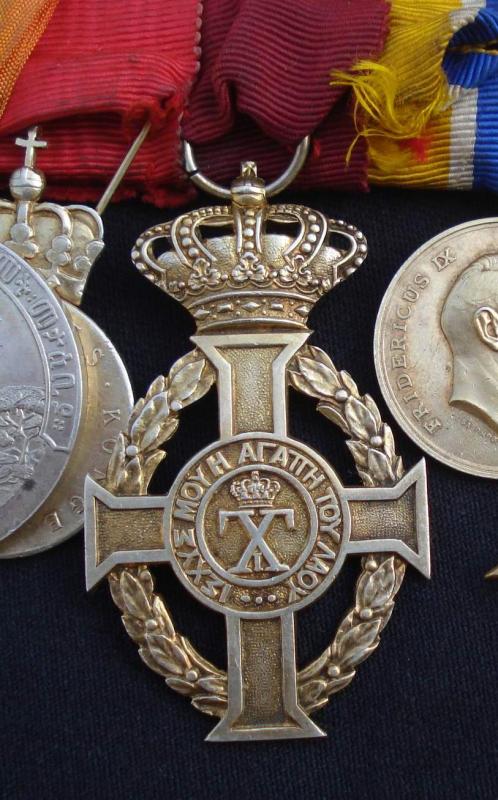
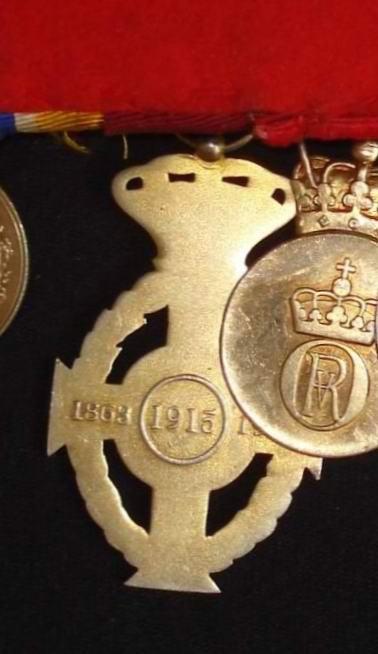 0
0 -
Dear Herman,
Many thanks for this welcome advice - can I ask on what basis you believe it is the gold medal? I agree that it would be the civil version as the group has no suggestion that it could be a military set or awards. (I have also written to the vendor if he has any idea as to whether the missing award is the order or medal.)
I note from previous posts in the forum that the spelling on the reverse of the Order changed in 1975 from "ZY" to "ZIJ" - is there a similar distinction on the reverse of the medal?
With kind regards,
Owain
0 -
And also the Belgian order, Owain
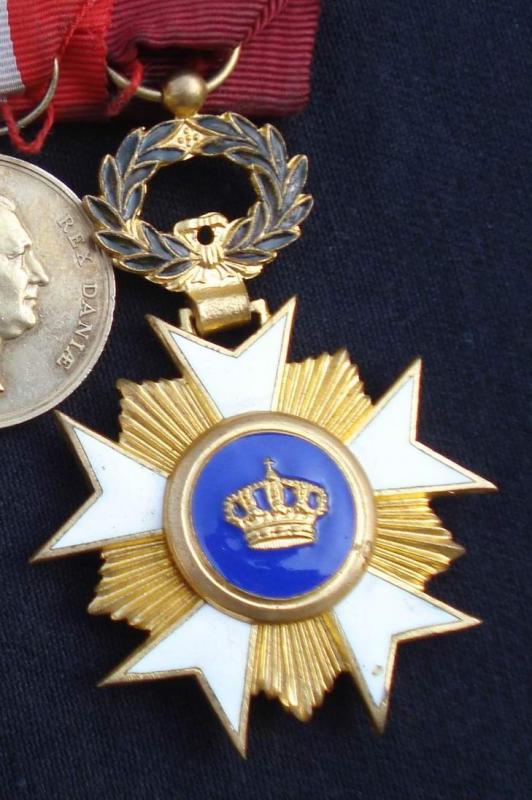
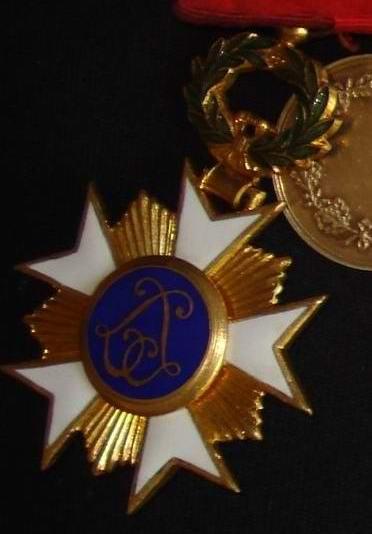 0
0 -
And now the Norwegian medal....
Owain
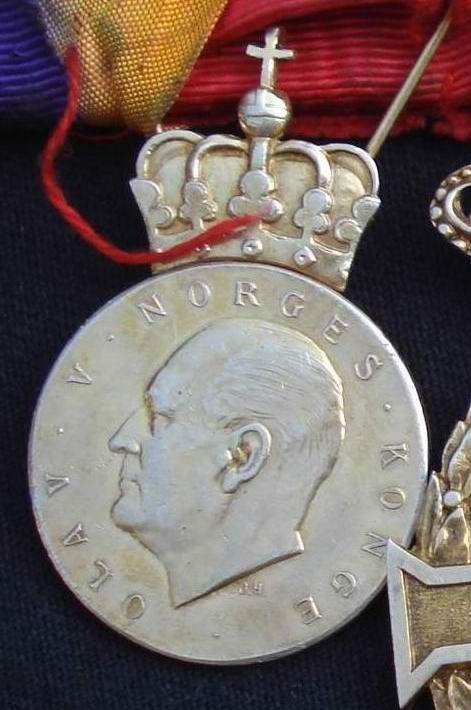
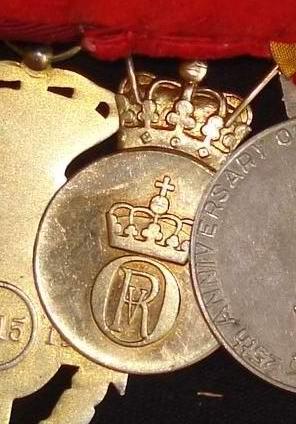 0
0 -
Gentlemen,
Many thanks for your input - all information is welcome. I attach images of the Danish medal.
Regards, Owain

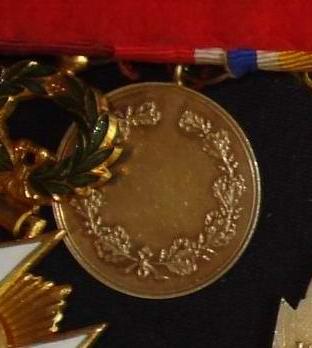 0
0 -
Michael,
Many thanks for your prompt response - I will amend the title of the Danish medals accordingly. The number of medals issued you note was 1953 - does this figure include awards to foriegners?
Ulsterman,
Thank you also for your input - all good stuff. Do I now infer the missing Orange-Nassau is a medal 1st Class? Access to the Negerat Gazetta would be nice but I suspect it is not on line!
Kind regards and thank you to you both.
Owain
0 -
Gentlemen,
I attach an image of the reverse of the group.
Regards, Owain
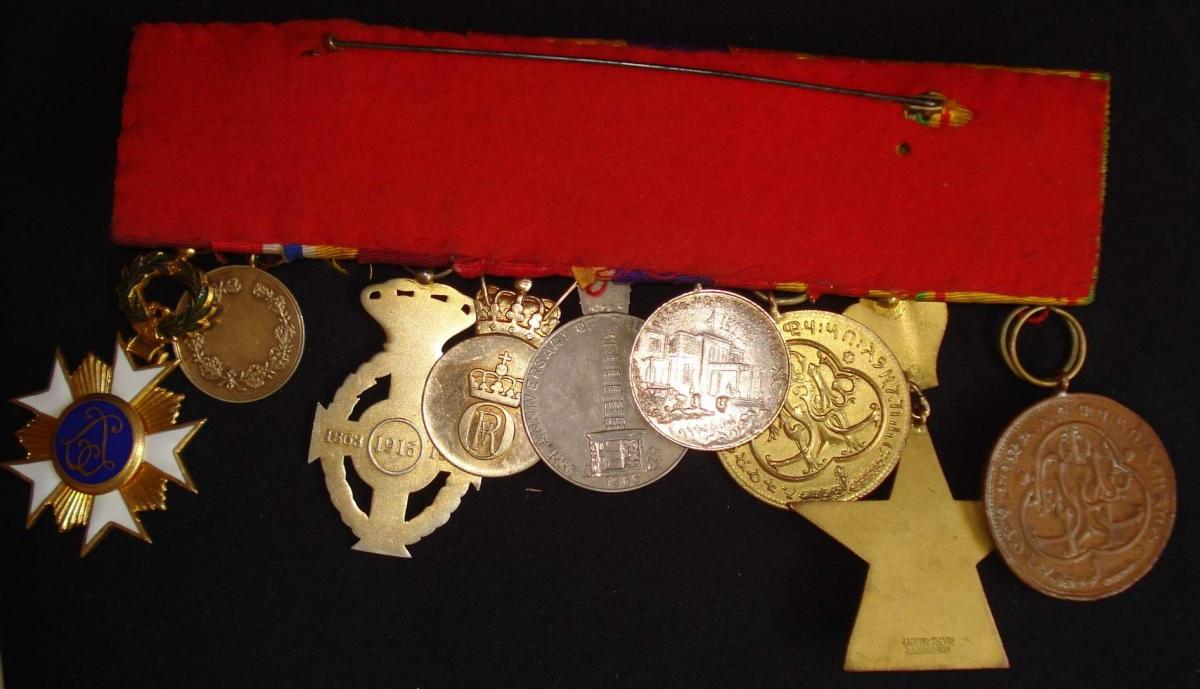 0
0 -
Gentlemen,
I have recently had the good fortune to obtain an interesting Ethiopian group, which although missing two medals, is a group which I should be able to complete. The mounted group consists of :
- Order of Menelik, 4th Class (missing and a "spare worn Haile Selassie merit medal has been substitutued)
- Order of the Star, 4th Class
- Large gilt Haile Selassie Medal of Merit
- Haile Selassie Jubilee Medal
- 25th Anniversary of Liberation Medal
- Norway - Medal of Olav V
- Greece - Order of George I, 6th Class
- Holland - Order of Orange Nassau, 5th Class (or possibly medal?)
- Denmark - Royal Medal of Recompense (Frederick IX) - 2nd Type 1965-71
- Belgium - Order of the Crown, 4th Class
What attracted me to the group is that it was the first time I had seen a mounted group including the Jubilee and 25th Anniversary medals, both relatively scarce, especially the Jubilee medal. It also provides some scope for research in as much as I hope to be able to track down the state visits by Haile Selassie to the overseas countries or indeed visits by Heads of State to Addis Ababa.
From the grades of awards, both Ethiopian and from overseas, I would infer that the recipient was an official at the Court of Haile Selassie.
Whilst I should be able to source an Order of Menelik to complete the Ethiopian portion of the group my reasoning for posting this on the Northern European Forum is to ask fellow members with knowledge of such awards:
Is the missing Dutch order indeed the 5th Class of the Order of Orange Nassau or a Medal of the Order and if the latter of what grade? Was it a gilt medal removed because it was thought to be gold? Were the medals awarded to foriegners during state visits or were only orders presented?
With regard to the Danish and Norwegian medals - are these particulary scarce and are they well documented? Any information on these Danish and Norwegian awards would be welcome.
Finally with regard to the Begium Order of the Crown 4th Class - as it is mounted last and of the 4th Class, could this infer the increasing seniority or rank of the recipient assuming the foriegn awards are mounted in chronological order of receipt.
(I am not ignoring the Greek award but it is not the subject matter of this particular forum.)
Ideally what I need to do is track down the order of state visits to Ethiopia or by Haile Selassie to the countries represented in this group - perhaps a job for a wet weekend in January?
Many thanks in advance for any information provided.
Kind regards and festive greetings from Riyadh,
Owain Raw-Rees
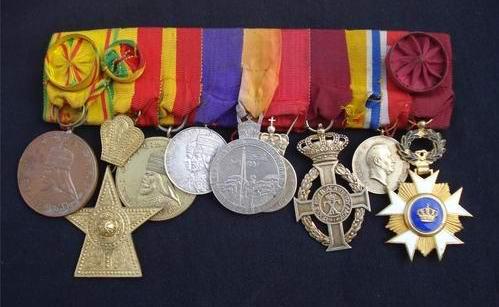 0
0 -
Gentlemen,
An image of the reverse of the group.
Owain
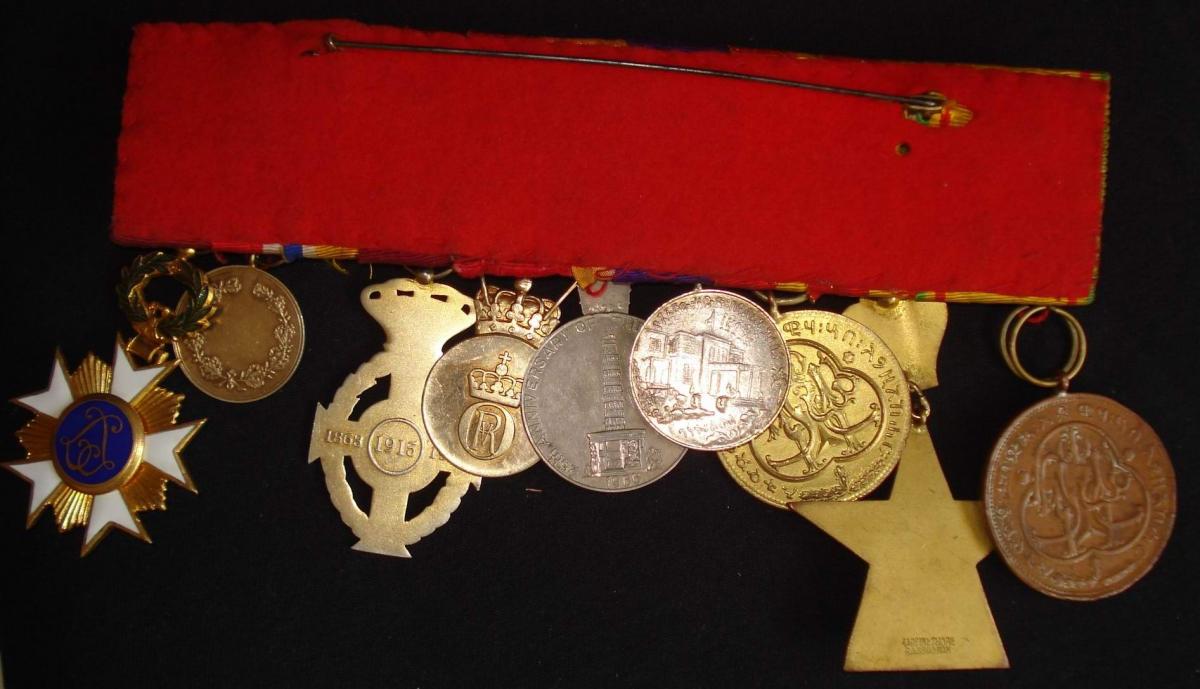 0
0 -
Gentlemen,
I have recently had the good fortune to obtain an interesting group, which although missing two medals, is a group which I should be able to complete. The mounted group consists of :
- Order of Menelik, 4th Class (missing and a "spare worn Haile Selassie merit medal has been substitutued)
- Order of the Star, 4th Class
- Large gilt Haile Selassie Medal of Merit
- Haile Selassie Jubilee Medal
- 25th Anniversary of Liberation Medal
- Norway - Medal of Olav V
- Greece - Order of George I, 6th Class (thank you Emannuel)
- Holland - Order of Orange Nassau, 5th Class (or possibly medal?)
- Denmark - Medal of Frederick IX
- Belgium - Order of the Crown, 4th Class
What attracted me to the group is that it was the first time I had seen a mounted group including the Jubilee and 25th Anniversary medals, both relatively scarce, especially the Jubilee medal. It also provides some scope for research in as much as I hope to be able to track down the state visits by Haile Selassie to the overseas countries or indeed visits by Heads of State to Addis Ababa.
From the grades of awards, both Ethiopian and from overseas, I would infer that the recipient was an official at the Court of Haile Selassie. Whilst I should be able to obtain an Order of Menelik without great difficulty a challenge I have is to ascertain whether the missing Dutch order is indeed the 5th Class of the Order of Orange Nassau or a Medal of the Order and thus I will also post this topic in the European (Netherlands) forum - that forum may also be able to provide further information on the Danish and Norwegian awards.
KInd regards and festive greetings from Riyadh,
Owain Raw-Rees
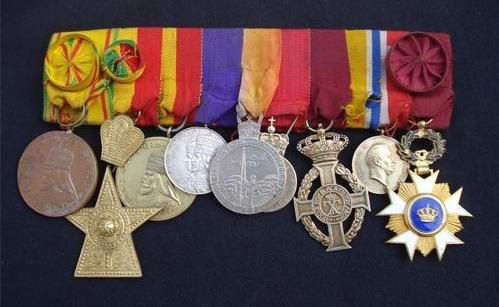 0
0 -
Gentlemen,
At last I have a translation of the "Best Cow" medal
Obverse
- His Majesty Haile Selassie I King of Kings
- 21 First Government Era (Not sure if this is acurate or makes sense)
Reverse
- Ethiopia International Agricultural Exhibition
- Second Prize - Horned Cattle
- 1944 Addis Ababa (if this is correct it corresponds to 1951 or so)
Not quite the Agricultural Order I was hoping for but nonetheless a nice piece and much fun in the negotiation for it. Finally earlier Chris noted his annoyance at the loss/confiscation of a chocolate Victory Star - I saw one or two of these and I am 99% certain that such pieces are unfinished awards which had not been silvered for issue and were from Sevadjian stock looted/liberated after 1974.
Regards, Owain
0 - His Majesty Haile Selassie I King of Kings
-
-
-
Gentlemen,
Back in Riyadh - a successful trip - no hassle at at all at the airport - all very quite. The medals were in the hold luggage. I must have visted over 30 different shops and almost all had medals but the vast amount were without ribbon and in poor condition - both pre and post Selassie periods. Haggling and revisiting some shops was necessary and indeed some prices being asked - no doubt due to me being a Westerner - were ridiculous. The ability to walk away is a necessity - indeed one store had a small trunk full of miniatures and other bits and pieces but the owner wanted to charge full medal price for the miniatures and would not compromise so no deal. Also evident were many unfinished medals and parts of orders, much of which I am sure had been liberated from the Sevadjian factory after the fall of Selassie. A key issue was the lack of medal ribbons, and indeed medal ribbon bars, of which I saw only a few and all badly damaged, and thus unless the piece was particularly scarce to my mind it was not worth persuing. Anway my haul for the trip is as follows:
Menelik Service Medals (small diameter) - 1st (gilt) and 2nd (silvered) at Birr 250 each ($13.89).
Selassie Service Medals (large diameter) - 1st (gilt) & 2nd (silvered) at Birr 250 each ($13.89).
Selassie Police Medal - 1st (gilt) (x 2 - one in original issue paper envelope) at Birr 250 & Birr 150 ($13.89 & $8.33) - 2nd Class not seen anywhere even without ribbon.
Chaplains Medal - 1st (gilded base medal) - at Birr 250 (13.89) - not sure if this is a one or two class award - poorly struck (cast?) and no ribbon.
Congo Medal - at Birr 200 ($11.11)
UN Korea - Ethiopia issue at Birr 450 ($25.00)
1956 Silver Jubilee Medal - at Birr 750 ($41.67) the only other example I saw was without ribbon and the asking price was Birr 4,000 ($222.22) - Ha!
"Best Cow" medal - some from of agricultural prize award (?) at Birr 750 ($41.67) - loop suspension but no ribbon.
I wil post images of these in the next few days. I already have a number of Ethiopian awards in my collection thus I limited my purchases search to what I did not have.The only medals I did not buy which I did not have were silver Victory stars and the Korea medals in silver and silvered base metal - no ribbon was available for these and thus I passed - perhaps when I vist again.
Finally one note of caution - there were a number of Order of Solomon badges for sale - on close inspection the star badges may have been Sevadjian castings but subsequently attached to crudely made suspension crowns - these were being sold as neck pendants - they should not be confused with genuine orders - one international dealer has one being offered as scare locally made variant!
Anyway that is it for now and thank you for your interest and advice. Regards, Owain
0 -
Chris, No it was at one of a cluster of shops just off Churchill Avenue - I'll return there later to day. This morning off with friend to the Mercato Market - supposedly the biggest open air market in Africa - a friend is giving us his driver as a guide and apparently there may be medals there...as they say in Saudi "Insh allah"! Owain
0 -
Just back from a day of tourism & browsing. Lost of medals for sale but. I suppose inevitably, all of the common place pre & post Selassie stuff - invariably well worn or damaged and without ribbons - great fun browsing though. Once possible find is a Hero of the Republic large silver neck badge but no price yet - some of the red enamelling on the central star is missing. A star of Shebe at $500 was a definite walk away. I will go back tomorrow morning for another browse - I have my eye on a Halie Selassie Prize Medal for the Best Cow - at Birr800 or $40 I should be able to negotiate it down. So far no looose ribbons or ribbon bars but I will keep on looking. Owain
0 -
Megan, No problem. Owain
0 -
Good evening from the Radisson in Addis. Arrived this morning from Riyadh for three nights - a three hour flight, no time difference, visa easily available at the airport for $20 - all very convenient. The only real hassle was getting a yellow fever jab in Riyadh to comply with Saudi re-entry regulations. Draught St. George's beer is most welcome after the delights of Riyadh homebrew! Tomorrow off on a medal hunt to Churchill Road and I am confining my purchases, if any, to post Selassie items with a maximum cost of $10 (??)per medal - I'll report back on whether my "rules" are complied with in due course. Advice from hotel and airport staff is be modest in your purchases - a kilo of of bling will attract attention, get reciepts, and pack in hold luggage. I'll keep you posted. Off for another St. George! Owain
0 -
I hope my notes below help.....Owain
The Medal of Liberation of the Senoussi Army
Obverse Reverse
Obverse In the foreground the flag of the Senoussis, black with crescent and star, superimposed upon the rising sun above the sands and on either side a sundered chain.
Reverse In the centre the Arabic inscription, “Medal of Liberation of the Senoussi Army” and the date “9 August 1940”. In the exurge beginning at the three o’clock position the inscription from the Koran “And those who believe and adopt exile and fight for the Faith, in the cause of God, as well as those who give them asylum and aid – these are all in very truth the Believers: for them is the forgiveness of sins and a provision most generous,” (Chapter 8, Verse 74).
Ribbon 12.5mm red ribbon with a central 5mm band of four black and three white stripes.
In June 1940 Italy entered the Second World War as an ally of the Nazi Germany and many Libyan exiles, an estimated 14,000 in Egypt alone, saw this involvement in the war as an opportunity to free their country from Italian rule. Under the leadership of Idris support for the British war effort became mobilised and in Cairo, in August 1940, the exiles passed resolutions calling for participation in the war alongside the British forces and under the banner of the Senoussi. “A recruiting office was opened in Egypt and five infantry battalions of volunteers were eventually mustered as the Libyan Arab Force. These troops made a marginal contribution to the allied war effort in North Africa. Some were present during the fighting in the Derna-Tobruk sector in early 1942, but the Libyan Arab Force was as a whole, only a gendarmerie, fulfilling police and guard duties as ‘base troops’ well behind the lines, and thereby relieving front line units of these routine but very necessary tasks.” (John Wright, Libya A Modern History.) Following independence the veterans of the Senoussi Army formed the nucleus of the Royal Libyan Army. I would suggest that this medal was instituted to recognise the service of the members of the Libyan Arab Force or Senoussi Army. (Manufactured by Bichay of Cairo.)
The symbolism of the ribbon’s colours can be equated to the symbolism attaching to the flag of the Kingdom. A popular Libyan poem reads,
“Our deeds are the colour of white,
Our battles of black,
Our meadows of green,
And our swords of red.”
1 -
Dear Moheb,
In haste and away from my data base, I can advise that of the Egyptian manufactured pieces for the monarchy - to date I have no evidence of other manufacturers - for the period 1915 to 1952, have the reverse of the orders, 5 classes, marked as follows:
A - Lattes in Latin script and occasionally in Arabic script.
B - Bichay (Tewfic Bichay) in Latin script.
C - Bichay (Fahmy Tewfic Bichay) in Arabic script.
Whilst the design of the order is constant the early pieces by Lattes have silvered rather than gilded rays on the body of the star. Some pieces - all manufacturers, have the crown suspension and central circular ring in gold as opposed to the usual silver gilt.
I hope this helps.
Kind regards,
Owain.
P.S. The Republic order of the same name whilst retaining the ribbon colours, consists only of a collar and a grand cordon class and are of a different design.
0



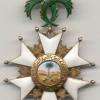
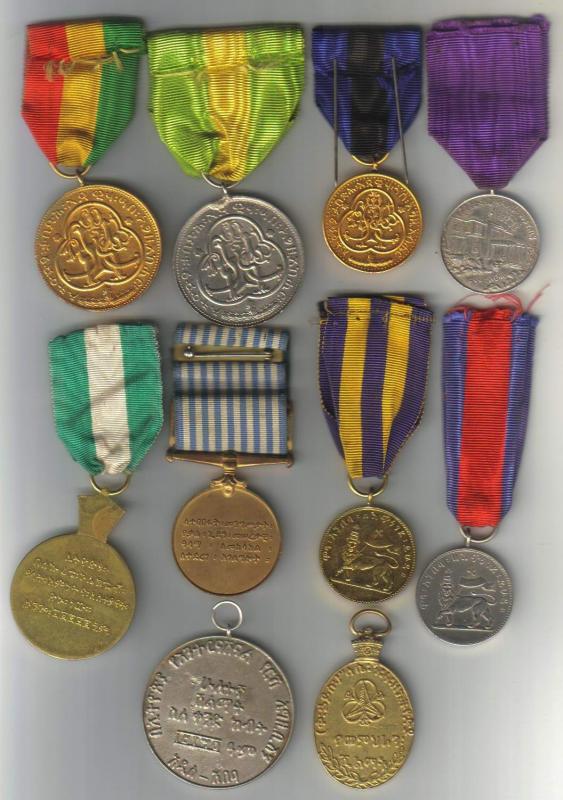
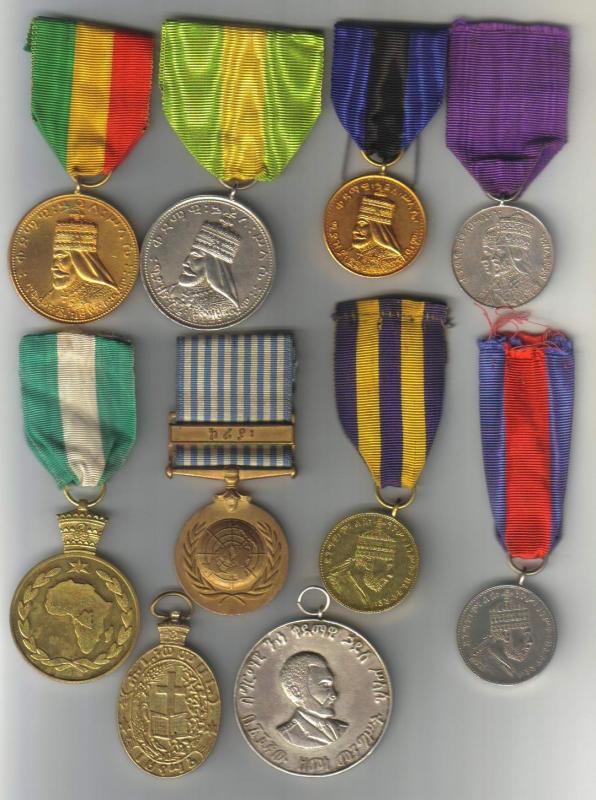
Africa General Service Medal , clasp "Kenya"
in Great Britain: Orders, Gallantry, Campaign Medals
Posted
Dear Brett, Mervyn, Azyeoman and Chris,
Many thanks for your kind words. I have been asked if I had known the story of "the man behind the medal" would I have still parted with it? I hope the answer would still have been yes, but the fact is that without GMIC none of us would have known the story of Eric Rundgren and thus the question is a non-starter. I have enjoyed the correspondence with Brett and Pat Rundgren and this represents a much more fulfilling exprience than just selling the medal.
I noted to Pat that it may well be that my grandfather would have met Eric as my grandfather, a John Edward Arnold Evans (1901-1990), was based in British East Africa from 1933 to 1958 and ended his career with Barclays DCO as manager of the Nairobi office and I remember him telling me how he slept with a revolver under his pillow during the Mau Mau troubles for which Eric received his medal. My mother was brought up in BEA and with my grandmother, and brother, born in Arusha (then in Tangyanika), went on leave by ship to the UK in the summer of 1939 with my grandfather to follow. With the onset of war my grandfather could not join them and they did not see each other again until after the war ended in 1945....but I digress.
Christmas greetings to all and best wishes for a peaceful and prosperous new year, Owain